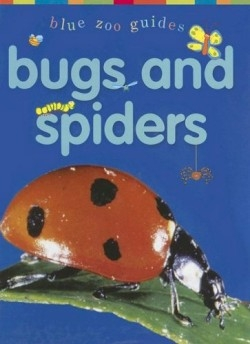
Bugs and Spiders (Blue Zoo Guides)
The humble firefly, giving so much pleasure as it flashes light on summer nights, has a dark side: it eats insects, slugs, and snails and even other fireflies. A brown bedbug changes color to red after drinking blood. Yuck! These are among the amazing facts that the author shares with readers ages four to eight in this buggy book. Even ladybugs offer some surprises: “When it is cold, ladybugs huddle together to keep warm.” The stinkbug is also called the parent bug, because the female “guards her eggs and cares for the nymphs after they hatch.” These intriguing tidbits accompany colorful pictures of the bugs and spiders, along with a graphic indicating the creature’s size, a depiction of its life cycle, and a photograph.
While the picture-book format will fascinate younger readers, the information and use of correct terminology (cephalothorax, abdomen, pupa, predators, camouflage) provides satisfying scientific information for older ones. There are some seeming omissions, however, in the text. It’s the firefly larva that has the unusual eating habits, not the adult, and bedbugs are parasites that bite humans, not just animals. Among the facts, Phillips also offers explanations, like: “The earwig got its name because people used to believe that it crawled into their ears when they were asleep. But they don’t really do that.” The author goes on to say, in an anthropomorphic judgment, that earwigs are “good mothers,” tending their eggs and licking them clean until they hatch.
The book’s title should have included the word “Etc.” because leeches and slugs are included, which are invertebrates, not bugs or spiders. Phillips explains this in the introductory material, but since children might not read or understand this section, youngsters might find this inclusion confusing. A better choice might have been to discuss additional bugs and spiders from the more than a million species on earth.
Phillips has been working as an editor and a writer of children’s books for nearly ten years. Here, she explains that all bugs, except the scorpion, start life as an egg. The life cycle chart shows the development of each creature, some heading from egg to nymph and adult, while others evolving from egg to larva to pupa then adult. Like Mammals, another book Phillips wrote in the Blue Zoo Guides, this book might have benefited from having symbols or text indicating where each bug or spider species is found.
Even if the insect world is not initially as appealing as that of mammals, the information in Phillips’s book is enough to turn a reader’s initial “yuck!” into “wow!”
Reviewed by
Linda Salisbury
Disclosure: This article is not an endorsement, but a review. The publisher of this book provided free copies of the book to have their book reviewed by a professional reviewer. No fee was paid by the publisher for this review. Foreword Reviews only recommends books that we love. Foreword Magazine, Inc. is disclosing this in accordance with the Federal Trade Commission’s 16 CFR, Part 255.
